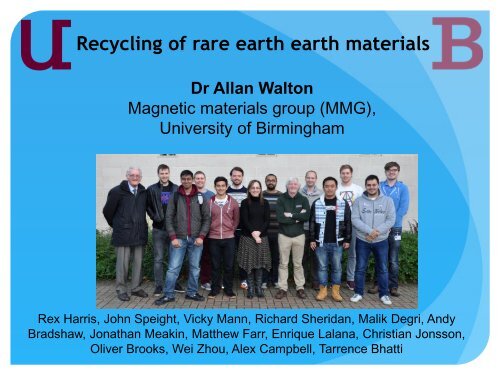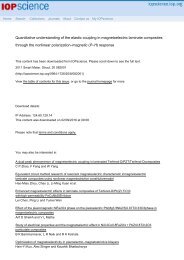Recycling of rare earth earth materials
Create successful ePaper yourself
Turn your PDF publications into a flip-book with our unique Google optimized e-Paper software.
<strong>Recycling</strong> <strong>of</strong> <strong>rare</strong> <strong>earth</strong> <strong>earth</strong> <strong>materials</strong><br />
Dr Allan Walton<br />
Magnetic <strong>materials</strong> group (MMG),<br />
University <strong>of</strong> Birmingham<br />
Rex Harris, John Speight, Vicky Mann, Richard Sheridan, Malik Degri, Andy<br />
Bradshaw, Jonathan Meakin, Matthew Farr, Enrique Lalana, Christian Jonsson,<br />
Oliver Brooks, Wei Zhou, Alex Campbell, Tarrence Bhatti
ERECON – European Rare Earth<br />
Competency Network<br />
80 European <strong>rare</strong> <strong>earth</strong>s experts from industry, academia,<br />
and the policy world<br />
Under the guidance <strong>of</strong> a high-level Steering Committee,<br />
three working groups have examined challenges and<br />
solutions for -<br />
(1) Mining <strong>rare</strong> <strong>earth</strong>s in Europe,<br />
(2) <strong>Recycling</strong> and substituting <strong>rare</strong> <strong>earth</strong>s<br />
(3) Fostering new business models for creating a more<br />
resilient, competitive, and sustainable European <strong>rare</strong><br />
<strong>earth</strong>s supply chain
Working group 2 - <strong>Recycling</strong><br />
<strong>of</strong> Rare Earths<br />
The aims for working group 2 were as follows –<br />
• To identify the potential for recycling <strong>of</strong> <strong>rare</strong> <strong>earth</strong>s in the EU.<br />
• To identify barriers to recycling <strong>of</strong> <strong>rare</strong> <strong>earth</strong>s.<br />
• To prioritise <strong>rare</strong> <strong>earth</strong> sectors where recycling should be<br />
targeted.<br />
• To identify products within these sectors where recycling<br />
could be applied more easily.<br />
• To identify technology gaps for recycling <strong>of</strong> <strong>rare</strong> <strong>earth</strong>s within<br />
the EU.<br />
• To produce a list <strong>of</strong> recommendations for the EU to promote<br />
recycling <strong>of</strong> <strong>rare</strong> <strong>earth</strong> <strong>materials</strong> .
What are the advantages<br />
<strong>of</strong> a recycled source <strong>of</strong> <strong>rare</strong> <strong>earth</strong>s<br />
• It would be possible to target the most critical <strong>rare</strong> <strong>earth</strong>s and<br />
address the balance problem.<br />
• A recycled source will not contain radioactive material<br />
• The time to market for a recycled source is likely to be shorter<br />
than a primary mined source in the EU.<br />
• A lower environmental footprint.<br />
• The potential for all the steps to be performed in the EU<br />
• The EU has one <strong>of</strong> if not the most advanced recycling industries<br />
in the world. Huge potential to innovate
Magnets and Phosphors were<br />
identified as a priority.<br />
Priority list for<br />
<strong>rare</strong> <strong>earth</strong><br />
magnets<br />
1) Hard disk drives, DVD and CD players<br />
2) Automotive applications<br />
3) Motors in industrial applications<br />
4) Loudspeakers<br />
5) Air conditioning compressors<br />
6) Magnetic separators<br />
7) Mixed electronics<br />
8) Electric bicycles<br />
9) Wind turbines
Examples <strong>of</strong> barriers for recycling<br />
• The urban mine is not fully understood for <strong>rare</strong> <strong>earth</strong>s<br />
• Insufficient and non targeted collection<br />
• Separation <strong>of</strong> <strong>rare</strong> <strong>earth</strong>s from the waste stream is <strong>of</strong>ten<br />
difficult due to small amounts <strong>of</strong> material, coatings,<br />
complicated architectures etc…<br />
• Re-processing technologies have to be optimised for a<br />
recycled source with a range <strong>of</strong> compositions and impurities.<br />
• In the current policy framework a recycled source has<br />
to be cheaper than primary production from China
Examples <strong>of</strong> technical barriers<br />
to recycling <strong>of</strong> <strong>rare</strong> <strong>earth</strong><br />
magnets
Separation <strong>of</strong> NdFeB from<br />
the waste stream<br />
screw<br />
Spindle motor<br />
containing resin<br />
bonded NdFeB<br />
magnet<br />
Disk<br />
Casing<br />
Voice<br />
Coil<br />
Motor<br />
Photograph <strong>of</strong><br />
shredded hard disk<br />
drives. Walton et al.<br />
HDD<br />
Screws<br />
Voice Coil<br />
Assembly<br />
Computer hard disk drive<br />
Sintered<br />
NdFeB<br />
Magnet
Barriers – Compositional variations<br />
<strong>of</strong> magnets in scrap<br />
Dy content (wt%) <strong>of</strong> sintered NdFeB magnets from HDDs (voice coil) as a<br />
function <strong>of</strong> year and manufacturer (each symbol type represents one<br />
manufacturer).<br />
HDD’s provided by Stena Technoworld AB, ICP analysis performed at Leitat<br />
Technology Centre Barcelona as part <strong>of</strong> the EU Framework 7 project Remanence.
The use <strong>of</strong> hydrogen to process HDDs
Separation <strong>of</strong> NdFeB from VCM<br />
Ni electroplate<br />
S<strong>of</strong>t magnetic<br />
Fe casing<br />
Hydrided<br />
NdFeB<br />
powder<br />
Voice coil assembly<br />
extracted from hard<br />
drive<br />
Voice coil assembly after<br />
Hydrogen processing.<br />
Ni electroless plated<br />
voice coil magnet
Prototype reactor for separating NdFeB magnets from WEEE<br />
Hard disk drives loaded into porous drum<br />
Figure . Hard disk drives loaded within the tumbling<br />
stage<br />
Hydrogen vessel<br />
Valve set<br />
Collection<br />
vessel<br />
Porous rotating stage inside vessel
Extracted powders<br />
Material extracted from<br />
tumbling stage (10<br />
sectioned HDDs).<br />
Optical micrograph <strong>of</strong> a<br />
cross section through a<br />
HD processed sintered<br />
NdFeB magnet particle<br />
The Ni content <strong>of</strong> the extracted powders for<br />
5kg <strong>of</strong> material was around 400ppm after<br />
sieving to 90 microns<br />
Sieving with ball<br />
bearings has been used<br />
to preferentially break<br />
down the NdFeB<br />
compared to the Ni and<br />
other impurities
Options for re-processing
Re-processing routes for<br />
<strong>rare</strong> <strong>earth</strong> magnets<br />
Source: Roland Gauß, Oliver Diehl, Oliver Gutfleisch,<br />
Fraunh<strong>of</strong>er Project Group IWKS.
Key recommendations<br />
• Map the urban mine to assess the potential for recycling<br />
• Design for recycle<br />
• Modify waste directives to take into account the critical <strong>materials</strong><br />
• Schemes to improve collection rates eg – incentives.<br />
• R&D and pilot plant development to improve the detection,<br />
separation and purification <strong>of</strong> <strong>rare</strong> <strong>earth</strong> <strong>materials</strong> from waste<br />
streams.<br />
• R&D and pilot plant development on re-processing technologies –<br />
eg- hydrometallurgy, pyrometallurgy,re-sintering, HDDR etc….
(Rare Earth Magnet Recovery for Environmental and Resource Protection)<br />
The organisations involved in the consortium are:<br />
• C-Tech Innovation Ltd,<br />
• The University <strong>of</strong> Birmingham,<br />
• Stena Technoworld AB,<br />
• ACREO Swedish ICT AB,<br />
• Leitat Technological Centre,<br />
• OptiSort AB,<br />
• Chalmers Industriteknik,<br />
• Magneti Ljubljana,<br />
• Kolektor Magnet Technology GMBH.<br />
Partner in an ITN Training network EREAN run by Koen Binnemans<br />
(Leuven).
Acknowledgements<br />
HyProMS (TSB project in the UK (2008-2010)) : Hydrogen Processed Magnet Scrap<br />
Partners - PowdermatriX (Project Managers),Secure IT <strong>Recycling</strong> Ltd, Less Common Metals<br />
Ltd, Magnet Applications Ltd, Precision Magnetics Ltd, Birmag Ltd, Arnold Magnetics.<br />
Publications –<br />
A.walton, I.R.Harris, A.J.Williams – REPM 2012<br />
R.S. Sheridan, A.J. Williams, I.R. Harris, A. Walton – REPM 2012.<br />
A.Walton, A.J.Williams – Materials World – August 2011<br />
A.Walton, A.J.Williams – <strong>Recycling</strong> International, May 2011<br />
M. Zakotnik et al, I.R.Harris, A.J.Wiliams. - Journal <strong>of</strong> Alloys and Compounds 469 (2009)<br />
314–321.<br />
M. Zakotnik, I.R.Harris, A.J.Williams - Proceedings <strong>of</strong> 19th International Workshop on Rare<br />
Earth Permanent Magnets & Their Applications (2006)<br />
M. Zakotnik, A.J. Williams and I.R. Harris - Proceedings <strong>of</strong> 18th International Workshop on<br />
Rare Earth Permanent Magnets & Their Applications (2004)<br />
US patent – No.13/169839<br />
Contact details –<br />
Dr Allan Walton a.walton@bham.ac.uk , 0121 414 5195, www.magnets.bham.ac.uk
Mining<br />
Refining<br />
Hydrogen<br />
Decrepitation<br />
Cast Alloy<br />
HD Powder<br />
Hydrogen Recycled<br />
NdFeB<br />
powder<br />
Jet Milling<br />
HDDR<br />
Processing<br />
Mix with<br />
epoxy<br />
resin and<br />
press into<br />
bonded<br />
magnets<br />
Mix with<br />
epoxy<br />
resin and<br />
press into<br />
bonded<br />
magnets<br />
Degas /<br />
Press<br />
Melt Spin<br />
Aligning & Pressing<br />
Vacuum Sintering<br />
Mix with resin and press into<br />
bonded magnets






